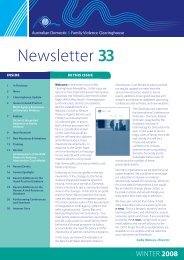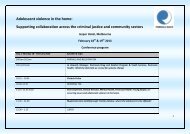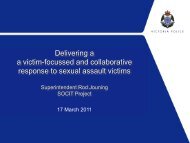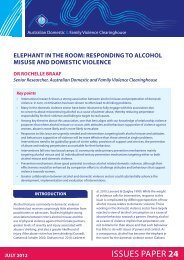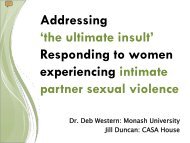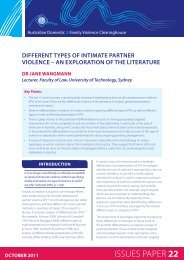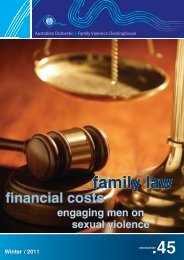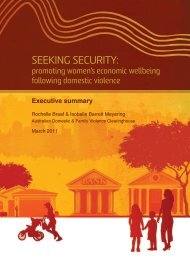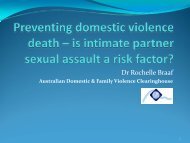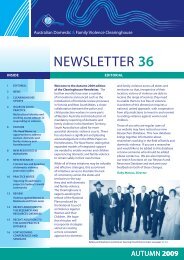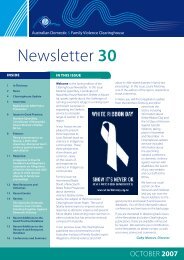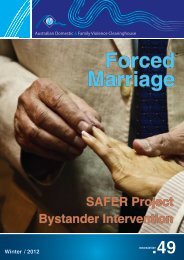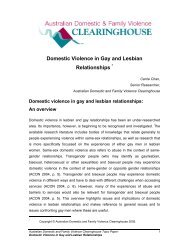Violence through our eyes - Women With Disabilities Australia
Violence through our eyes - Women With Disabilities Australia
Violence through our eyes - Women With Disabilities Australia
You also want an ePaper? Increase the reach of your titles
YUMPU automatically turns print PDFs into web optimized ePapers that Google loves.
control of reproduction and menstruation; and forced sterilisation and abortion (WWDA,<br />
1998).<br />
<strong>Violence</strong> against women with disability may be perpetrated not just by an intimate partner<br />
or spouse but by relatives; caregivers (paid and unpaid, male and female); co-patients/coresidents;<br />
residential and institutional staff; or other service providers.<br />
Research indicates that, regardless of age, race, ethnicity, sexual orientation or class,<br />
women with disability are assaulted, raped and abused at a rate of at least two to twelve<br />
times greater than women without disability (WWDA, 1998). However, they are much less<br />
likely to access or receive assistance or services if they experience violence.<br />
Power dynamics in relationships<br />
<strong>Women</strong> with disability are often perceived as being dependant on their partners and<br />
unable to participate equally in the relationship. In addition, the assumption that women<br />
with disability are asexual, or unable to parent a child, often portrays their partners as<br />
martyrs or heroes for being in a relationship with a woman with disability. This perception<br />
can lead to a form of emotional control over women with disability by their partners while<br />
disguised as ’caring support’.<br />
WWDA (1998) and <strong>Women</strong>’s Aid Federation of England, (2008) noted that women with<br />
disability can be practically, financially and/or emotionally dependent on their abuser/s. For<br />
some women, the assistance required to leave their carer/partner might not be available<br />
from other s<strong>our</strong>ces at short notice. Access to affordable and accessible transport and<br />
suitable accommodation are factors which limit women’s support options. As a<br />
consequence, women often tolerate abuse, viewing it as their only option.<br />
Moreover, if a woman with disability manages to escape, very few women’s refuges are<br />
accessible or willing to accept a woman with disability (and her children). Emergency<br />
accommodation facilities rarely have ramps, lifts, accessible showers or toilets, access to<br />
interpreter services, information in alternative formats, a telephone typewriter, provision of<br />
attendant/personal care, or appropriately trained staff. In addition, women with disability<br />
who have children fear that they will lose custody if authorities question their capability as<br />
the primary carers of their children.<br />
The few women with disability, who do gain access to a refuge, face the additional<br />
pressure of the lack of social housing dwellings that are accessible and long waiting lists<br />
for existing stock. The lack of transitional housing support programs and access to<br />
medium and long term accommodation for women with disability forces many women to<br />
continue living in situations where they are in immediate risk of harm.<br />
The Supported Accommodation Assistance Program (SAAP) plays an important role in<br />
supporting women with disability escaping violence. The SAAP provides crisis and<br />
transitional support and accommodation services to homeless people and those at risk of<br />
homelessness to help them achieve self-reliance. It is essential that women with disability<br />
are able to access SAAP services before they transition to long term housing.<br />
Culture, Disability and <strong>Violence</strong><br />
For women from NESB with disability, their experiences of violence are compounded by<br />
cultural assumptions and stereotypes regarding gender and disability. There are three<br />
assumptions among services providers about people from NESB with disability which need<br />
to be dispelled.<br />
<strong>Violence</strong> <strong>through</strong> <strong>our</strong> <strong>eyes</strong> 12



